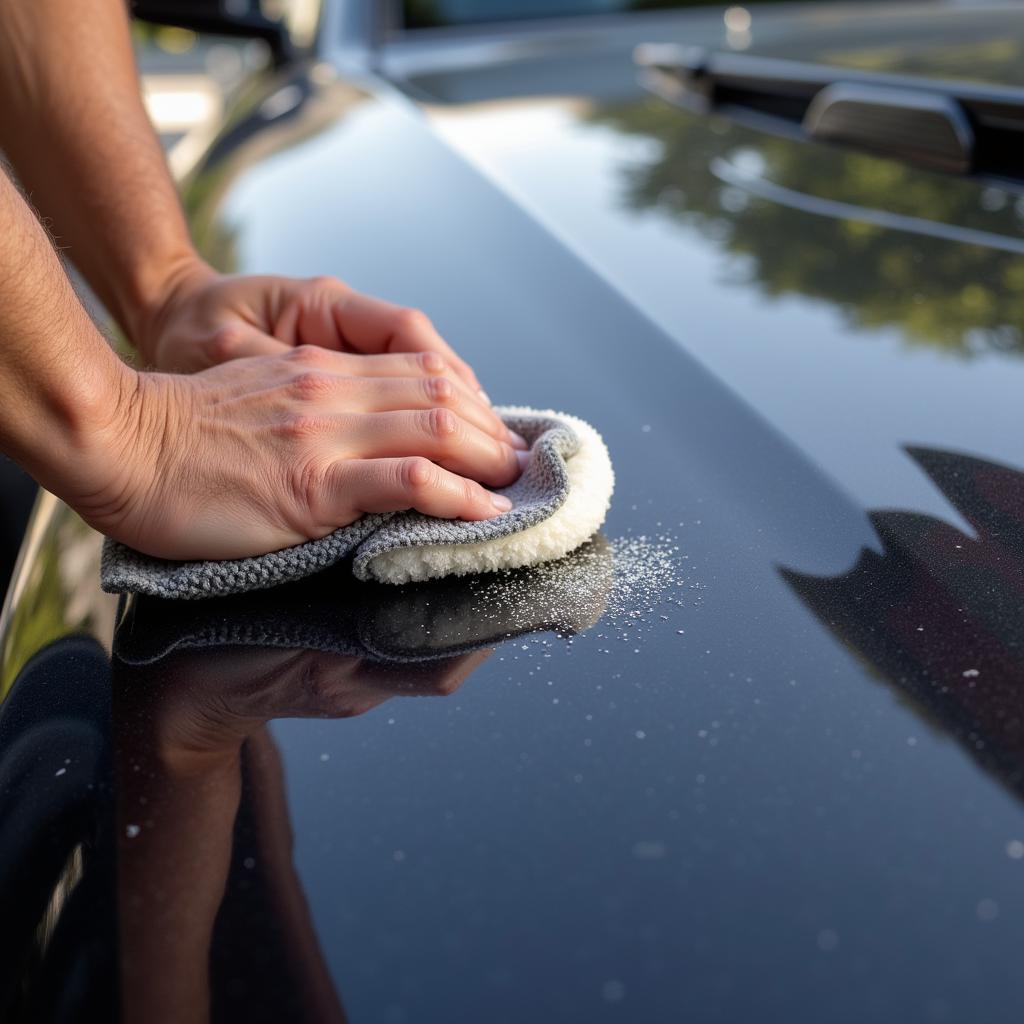Scratches on your car are annoying, but often, you can repair minor ones at home without professional help. This guide will walk you through identifying the scratch type, choosing the right repair method, and achieving a professional-looking finish. Let’s dive in and learn how to repair a scratch on your car at home. You might be surprised by how much you can achieve with a little patience and the right techniques. Learning how to repair a scratch on your car yourself can save you time and money, putting you back on the road with a gleaming vehicle in no time.
Identifying the Scratch: What Kind of Damage Are We Dealing With?
Before you start, it’s crucial to determine the scratch’s depth. This will dictate the appropriate repair method. A light scratch, affecting only the clear coat, can often be buffed out. A medium scratch, penetrating the paint layer, requires more attention. Deep scratches, reaching the primer or metal, might necessitate professional intervention or more advanced DIY techniques.
If you’re looking for other DIY car repairs, check out our guide on how to repair car bodywork.
Gathering Your Supplies: The Right Tools for the Job
Having the right tools is essential for a successful scratch repair. For light scratches, you’ll need a microfiber cloth, car wash soap, rubbing compound, and polishing compound. Medium scratches may require touch-up paint, primer (if the scratch reaches the metal), fine-grit sandpaper, and masking tape. Always ensure you have a clean, well-lit workspace to avoid further damage or imperfections.
Repairing Light Scratches: Buffing Away the Imperfections
Light scratches, often appearing as swirls or hazy marks, can usually be removed with rubbing compound. Wash the affected area thoroughly with car wash soap and dry it completely. Apply a small amount of rubbing compound to a microfiber cloth and rub it onto the scratch using circular motions. Once the scratch disappears, follow up with polishing compound to restore the shine.
 Buffing a Light Scratch on a Car
Buffing a Light Scratch on a Car
Repairing Medium Scratches: A Step-by-Step Guide
Medium scratches require a more involved approach. First, clean the area with car wash soap and dry it. If the scratch has reached the metal, apply a thin layer of primer. Once dry, apply several thin coats of touch-up paint, allowing each coat to dry before applying the next. After the final coat dries, wet sand the area with fine-grit sandpaper to blend the repair with the surrounding paint. Finish with polishing compound to restore the shine. You can learn more about fixing dents in our guide on how to repair car bumper dent.
Repairing Deep Scratches: When to Call a Professional
Deep scratches that expose bare metal require more advanced techniques. While some DIY methods exist, they are often complex and time-consuming. If you’re not comfortable with these methods, it’s best to consult a professional. They have the expertise and equipment to ensure a seamless repair.
 Professional Repairing a Deep Scratch on Car
Professional Repairing a Deep Scratch on Car
“Deep scratches often require professional attention due to the complexity of the repair process and the need for specialized tools and expertise,” says renowned auto body expert, John Miller.
Preventing Future Scratches: Protecting Your Car’s Finish
Regular washing and waxing are your best defense against scratches. Parking in shaded areas or a garage can also help protect your car’s paint from the elements. Consider using a car cover for added protection, especially during harsh weather conditions. For remote control car enthusiasts, learn how to repair your prized possessions in our guide on how to repair toy car remote control.
Conclusion: Maintaining a Scratch-Free Car
Repairing a scratch on your car at home can be a rewarding experience, saving you money and restoring your car’s appearance. By accurately assessing the scratch’s depth and following the appropriate steps, you can achieve professional-looking results. Remember, prevention is key, so regular maintenance and protective measures are essential for maintaining a scratch-free car. If you’re unsure about any aspect of the repair process, don’t hesitate to consult a professional. Now you know how to repair a scratch on your car at home!
FAQ
- Can I use toothpaste to repair car scratches? While some claim it works, toothpaste is not formulated for car paint and may cause further damage.
- How can I match the touch-up paint to my car’s color? Your car’s color code is usually found on a sticker inside the driver’s side doorjamb or in the owner’s manual.
- What grit sandpaper should I use for wet sanding? Start with 2000-grit and progressively move to finer grits like 3000-grit for a smooth finish.
- How often should I wax my car? Waxing every three to four months provides good protection.
- Can I repair a scratch on a leased car? It’s best to check your lease agreement before attempting any repairs. You might need to inform the leasing company.
Do you have a cracked windshield? Find out how to fix it in our article on how can repair car glass. Also, check out our guide on how to car driver repair for tips on improving your driving skills.
Need help with your car? Contact us via WhatsApp: +1(641)206-8880, or Email: [email protected]. Our customer service team is available 24/7.


